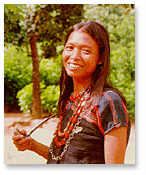Home » La Hu
The La Hu People

Going to the stream to get water
The La Hu are also known as Xa La Vang, Co Rung, Khu Sung and the Kha Quy. Now the La Hu have a population of more than 5,300, living in Muong Te district, Lai Chau province. The La Hu language belongs to the Tibeto-Burman group.
In the former days, the La Hu lived mainly on slash-and-burn cultivation and hunting and gathering with rudimentary tools including knives and hoes. In recent decades, the La Hu have cultivated rice as their staple food and used buffalo to drag loads. La Hu men are very skilled at making rattan chairs, trays, mats and flat baskets. Most of them are also competent blacksmiths.
The La Hu have set up villages on mountain slopes. Preferring a sedentary life, a number of La Hu villages have moved to the lowland. To replace their old temporary houses, they have built sturdier homes, mostly at ground level and divided by bamboo partitions. In the interior, the altar to the ancestors and the kitchen is always placed in the bay used as the head of the family’s bed.
Tools to be used in the La Hu’s daily life and production
La Hu men’s dress is like that of other ethnic groups in the northwest region. Some wear trousers and a long shirt, falling to their ankles, on ordinary days, and put on a short vest on festive days. The collar, chest stripes and sleeves are either embroidered or sewn with colourful pieces of cloth, silver or tin coins and red fringes.
In a La Hu family, the right of inheritance is reserved for the sons only. It is customary that young men and women are free to choose their partners and decide their marriage. After the wedding, the groom has to live with his wife’s family for several years, then he takes his wife to his house.
La Hu women give birth in their bedrooms. Three days later, the baby will be given a true name. But if an unexpected guest comes in the meantime, he or she is given the honour of naming the newborn.
The dead person is placed in a hollowed-out tree trunk. Neither a tomb or a protective fence are built on the grave. In fact, the worship of ancestors is reserved for dead parents
The La Hu in Muong Te (Lai Chau)
Every year, the La Hu hold ceremonies to worship the spirits of the earth to pray for peace. They involve the spirits of corn and rice after sowing and harvesting and worship the founder of blacksmithing.
The La Hu practise 12 different khen (pan-pipe) dances. Generally, young people like to play khen with a bamboo-box. The songs are sung in the Ha Nhi language but still keep their own rhythms. The La Hu possess a rich treasury of ancient tales and private calendars in which the days are defined corresponding to 12 animals including tiger, rabbit, dragon, louse, sheep, monkey, rooster, dog, pig, squirrel and buffalo.

